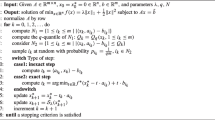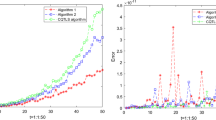Abstract
The Householder transformation is considered to be desirable among various unitary transformations due to its superior computational efficiency and robust numerical stability. Specifically, the Householder transformation outperforms the Givens rotation and the modified Gram-Schmidt methods in numerical stability under finite-precision implementations, as well as requiring fewer arithmetical operations. Consequently, the QR decomposition based on the Householder transformation is promising for VLSI implementation and real-time high throughput modern signal processing. In this paper, a recursive complex Householder transformation (CHT) with a fast initialization algorithm is proposed and its associated parallel/pipelined architecture is also considered. Then, a CHT based recursive least-squares algorithm with a fast initialization is presented. Its associated systolic array processing architecture is also considered.
Similar content being viewed by others
References
G.H. Golub and C.F. Van Loan,Matrix Computation, 2nd Ed. Baltimore, MD. Johns Hopkins University Press, 1989.
W.M. Gentleman and H.T. Kung, “Matrix Triangularization by Systolic Array,”Proc. SPIE Real-Time Signal Processing, IV, vol 298, 1981, pp. 19–26.
J.G. McWhirter, “Recursive Least-Squares Minimization Using a Systolic Array,”Proc. SPIE, Real-Time Signal Processing, VI, vol. 431, 1983, pp. 105–112.
R. Schreiber, “Implementation of adaptive array algorithms,”IEEE Trans. Acoust. Speech, Signal Processing, vol. ASSP-34, 1986, pp. 1038–1045.
J.G. McWhirter and T.J. Shepherd, “Systolic Array Processor for MVDR Beamforming,”IEE Proceedings, vol. 136, 1989, pp. 75–80.
C.R. Ward, P.J. Hargrave, and J.G. McWhirter, “A Novel Algorithm and Architecture for Adaptive Digital Beamforming,”IEEE Trans. on Antennas and Propagation, AP-34, 1986, pp. 338–346.
R. Schreiber and W.P. Tang, “On Systolic Arrays for Updating the Cholesky Factorization,” Swedish Roy. Inst. Technol., Dep. Numeric. Anal. Comput. Sci., Stockholm, Sweden, Tech. Rep. TRITA-NA-8313, 1983.
F. Ling, D. Manolakis, and J.G. Proakis, “A Recursive Modified Gram-Schmidt Algorithm for Least-Squares Estimation,”IEEE Trans on Acoustics, Speech and Signal Processing, vol. 34, 1986, pp. 829–836.
S.Z. Kalson and K. Yao, “Systolic Array Processing for Order and Time Recursive Generalized Least-Squares Estimation,”Proc. SPIE, Real-Time Signal Processing, VIII, vol. 564, 1985, pp. 28–38.
S.Z. Kalson and K. Yao, “A Class of Least-Squares Filtering and Identification Algorithms with Systolic Array Architectures,”IEEE Trans. on Information Theory, vol. 37, 1991, pp. 43–52.
James W. Longley,Least Squares Computations Using Orthogonalization Method, New York: Marcel Dekker, 1984.
J.G. Nash and S. Hansen, “Modified Faddeeva Algorithm for Concurrent Execution of Linear Algebraic Operations,”IEEE Trans. on Computers, vol. 37, 1988, pp. 129–137.
J.E. Hudson and T.J. Shepherd, “Parallel Weight Extraction by a Systolic Least Squares Algorithm,”Proc. SPIE, Advanced Algorithms and Architecture for Signal Processing, IV, vol. 1152, 1989, pp. 68–77.
J.G. McWhirter, “Algorithmic Engineering—an Emerging Discipline,”Proc. SPIE, Advanced Algorithms and Architecture for Signal Processing, IV, vol. 1152, 1989, pp. 2–15.
C.F.T. Tang, K.J.R. Liu, and S.A. Tretter, “On Systolic Arrays for Recursive Complex Householder Transformations with Applications to Array Processing,”Proc. IEEE Int'l. Conf. on Acoustics, Speech and Signal Proc., 1991, pp. 1033–1036.
C.F.T. Tang, “Adaptive Array Systems Using QR-Based RLS and CRLS Techniques with Systolic Array Architectures,” Ph.D. Thesis, Systems Research Center, University of Maryland, College Park, May, 1991.
L. Johnson, “A Computational Array for the QR Method,”1982 Conference on Advanced Research in VLSI, Cambridge, MA: MIT Press, 1982, pp. 123–129.
C.M. Rader and A.O. Steinhardt, “Hyperbolic Householder Transformations,”IEEE Trans. on Acoustics, Speech and Signal Processing, vol. ASSP-34, 1986, pp. 1589–1602.
A.O. Steinhardt, “Householder Transformations in Signal Processing.”IEEE ASSP Magazine, 1988, pp. 4#12.
J. Cioffi, “The Fast Householder Filters RLS Adaptive Filter.”Proc. Int'l Conf. on Acoustics, Speech and Signal Processing, 1990, pp. 1619–1621.
K.J.R. Lui, S.F. Hsieh, and K. Yao, “Recursive LS Filtering using Block Householder Transformations.” Proc. IEEE Int'l. Conf. on Acoustics, Speech and Signal Processing, 1990, pp. 1631–1634.
K.J.R. Liu, S.F. Hsieh, and K. Yao, “Systolic Block Householder Transformation for RLS Algorithm with Two-level Pipelined Implementation,” to appear inIEEE Trans. on Signal Processing, April 1992.
J.H. Wilkinson,The Algebraic Eigenvalue Problem, Oxford: Oxford University Press, 1965.
N.K. Tsao, “A Note on Implementing the Householder Transformation,”SIAM J. Numer. Anal., vol. 12, 1975, pp. 53–58.
C.R. Ward, A.J. Robson, P.J. Hargrave, and J.G. McWhirter, “Application of a Systolic Array to Adaptive Beamforming,”IEE Proceedings, vol. 131, Pt. F, 6, 1984, pp. 638–645.
S.M. Yuen, “Algorithmic, Architectural, and Beam Pattern Issues of Sidelobe Cancellation,”IEEE Trans. on Aerospace and Electronic Systems, vol. 25, 1989, pp. 459–472.
C.F.T. Tang, K.J.R. Liu, and S.A. Tretter, “A VLSI Algorithm and Architecture of CRLS Adaptive Beamforming,”Proc. of the Conf. on Information Sciences and Systems, 1991, pp. 862–867.
Author information
Authors and Affiliations
Additional information
This work was supported in part of the National Science Council of the R.O.C. under grant NSC80-E-SP-009-01A.
This work was supported in part by a UC Micro grant and NSF grant NCR-8814407.
Rights and permissions
About this article
Cite this article
Tang, C.F.T., Liu, K.J.R., Hsieh, S.F. et al. VLSI algorithms and architectures for complex householder transformation with applications to array processing. J VLSI Sign Process Syst Sign Image Video Technol 4, 53–68 (1992). https://doi.org/10.1007/BF00930618
Received:
Revised:
Published:
Issue Date:
DOI: https://doi.org/10.1007/BF00930618




